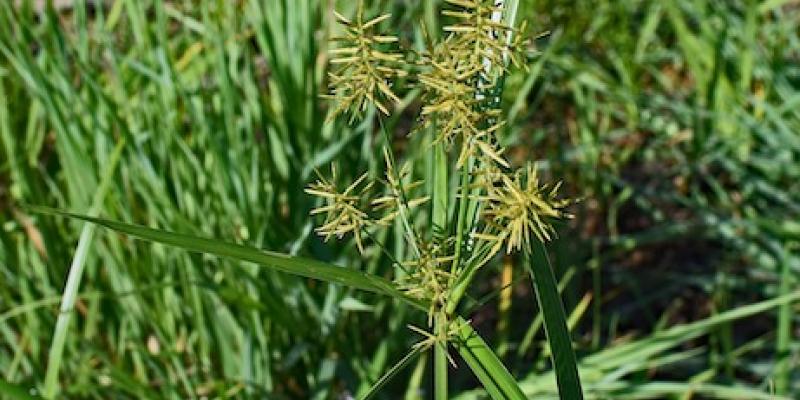How to Kill Nutsedge
Last edited: 6/15/22
Estimated read time: 4 minutes
Of all the weeds that can attack your lawn, nutsedge may be the most challenging to eradicate. A master of survival, this tenacious, drought-tolerant invader spreads aggressively and can overtake your grass in just a couple of growing seasons if left unchecked.
What is Nutsedge?
While most homeowners are familiar with broadleaf weeds, nutsedge is a different and more challenging species. Native to the Eastern hemisphere, the weed is not a true grass, but a grass-like plant called a sedge. Though it was first introduced to the United States in the 1850s as a potential vegetable crop, today, nutsedge is best known to American gardeners and homeowners as a virulent nuisance. Two common varieties—yellow and purple—are considered one of the worst weeds to find in your yard.
What Does Nutsedge Look Like?

While nutsedge resembles a grass at first glance, its size and spiky seed head set this weed apart.
- Purple nutsedge grows to around a foot or more in height and is crowned by reddish-purple seeds.
- Yellow nutsedge can reach almost three feet and produce yellow seeds.
The weed can also be differentiated from grass by its stems. Where grass stems are hollow and round, nutsedge stems are triangular and solid.
Nutsedge vs. Crabgrass
When weeds like nutsedge and crabgrass pop up on your lawn, it can be hard to tell them apart—but because different weeds respond to different treatments, it’s important to get it right.
- Crabgrass is an annual weed that usually shows up in late spring and early summer and is capable of thriving even in nutrient-depleted soil. When it first emerges, crabgrass looks like tiny corn plants but eventually grows in dense clumps of thick, hairy blades. Shoots emerging sideways from the clumps look like crab legs, giving the plant its name.
- Nutsedge is a perennial that favors moist soil, although, once established, they can thrive even in drier areas. While the weed can grow in clumps, they are not as large. Nutsedge can also be distinguished from crabgrass by the colorful seedheads.
How Does Nutsedge Spread?
Nutsedge’s ability to reproduce makes it one of the most formidable adversaries of healthy lawns. Its seeds or seedlings may sometimes be present in garden soil or plants purchased from the local nursery. As a perennial, nutsedge comes back year after year, spreading its reach through seed dispersal and its ever-expanding root system. Horizontal underground stems called rhizomes produce roots that form shoots and small nodules called tubers that store nutrients the plant needs for the next season’s growth.
The Damaging Effects of Nutsedge
Nutsedge is a master of self-preservation, crowding out other plants and leaching the soil of nutrients in the process. A single plant can produce nearly 2,000 shoots and 7,000 tubers in one growing season. Multiply this by hundreds of plants, and it’s easy to see how the weed can quickly choke out your lawn.
How to Eradicate Nutsedge
Nutsedge’s deep root system makes the weed challenging to eliminate. While some homeowners were able to get rid of the plant by digging it up or applying pre-emergent herbicides, even a little bit of the rhizome left behind is enough to help it regrow. The most effective way to kill off the weed is using herbicides containing sulfentrazone that are absorbed through the plant into the root system—though several applications may be necessary to get the job done.
Does Vinegar Kill Nutsedge?
Some gardeners have successfully used white vinegar to kill nutsedge, although multiple applications were necessary. If you are planning to try using vinegar, make sure that the acetic acid concentration of the vinegar is at least 10 percent. Sugar and water mixed with hydrogen peroxide and horticultural-grade molasses have also reportedly been effective against the weed.
Should You Pull up Nutsedge?
Trying and pulling up nutsedge can be tempting, and repeated pulling can weaken the plant. But pulling is more likely to kick this plant into survival mode, causing the rhizome left underground to put up more shoots. It’s nearly impossible to pull any plant up with such a deep root system. Assistance from a professional lawn care company is your best bet in battling this tough weed.
Nutsedge Prevention and Control
The most effective way to prevent and control nutsedge is through identification and eradication early in the growing season. It’s also important to make conditions less conducive to the weed’s growth:
- Nutsedge loves moisture, so make sure not to overwater your lawn and that it is well irrigated.
- Keep your lawnmower blade on the highest setting during the spring and summer growing season, so that surrounding grass will shade the weed and slow its growth.
If you need help getting rid of nutsedge, reach out to our knowledgeable and experienced technicians at 410-376-5643 for specialized treatment as part of our premium package.
Have a Question About Lawn Care? Ask the Experts!
Having a lawn care problem that you can’t seem to solve? Send your question to our expert technicians and get the answers you need to get a healthy, beautiful lawn.
Ask a Lawn Care QuestionConsider Professional Lawn Care
End the guesswork and stress of lawn maintenance. Let our experienced team put their expertise to work making your lawn healthy and beautiful.
Get a FREE Lawn Care Quote Now
Quick Quote Form
"*" indicates required fields
